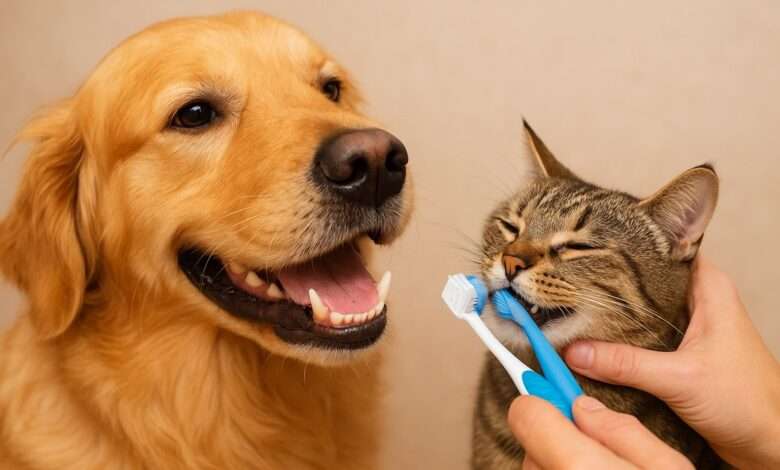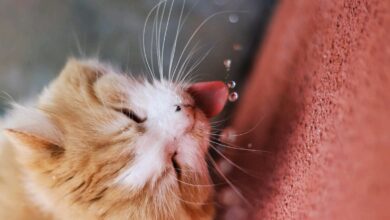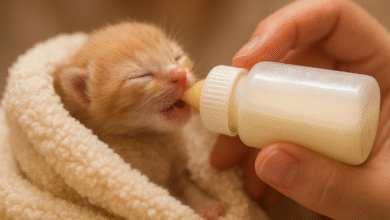Brushing Your Pet’s Teeth A Vet-Approved Guide to Prevent Dental Disease
Brushing Your Pet’s Teeth Can Prevent Dental Disease

Just like humans, pets need proper dental care to stay healthy and happy. Many pet parents don’t realize that brushing your pet’s teeth is just as important as feeding them the right food or taking them for walks.
Neglecting dental care can lead to bad breath, gum infections, tooth loss, and even heart or kidney disease in severe cases.
According to veterinary studies, over 70% of dogs and 60% of cats develop some form of dental disease by age three. The good news? Regular brushing can help prevent most dental problems before they even start.
What Is Pet Dental Disease?
Dental disease, also known as periodontal disease, is an infection of the tissues surrounding your pet’s teeth. It usually starts with plaque and tartar buildup caused by leftover food particles and bacteria in the mouth.
Over time, this buildup irritates the gums, leading to inflammation, bad breath, and eventually tooth loss if untreated.
Veterinarians classify dental disease in four stages, from mild gingivitis to severe bone loss.
Common Signs of Dental Disease in Pets
-
Bad breath (halitosis)
-
Yellow or brown tartar on teeth
-
Red or bleeding gums
-
Difficulty eating or chewing
-
Drooling more than usual
-
Pawing at the mouth or face
-
Loose or missing teeth
If you notice any of these symptoms, it’s time to visit your veterinarian for a dental checkup.
Why Brushing Your Pet’s Teeth Is So Important
Brushing your pet’s teeth is the best way to prevent dental disease. It helps remove plaque before it turns into tartar — something that brushing can handle but even the best dental treats cannot fully remove.
1. Prevents Painful Gum Infections
Plaque is soft and easy to remove. Once it hardens into tartar, it causes gum inflammation (gingivitis). Daily brushing keeps your pet’s gums healthy and infection-free.
2. Improves Overall Health
Poor oral hygiene doesn’t just affect the mouth — bacteria from infected gums can travel to the heart, liver, and kidneys.
Regular brushing reduces bacterial load and protects your pet’s overall health.
3. Keeps Breath Fresh
Nobody likes “doggy breath.” Brushing helps control bacteria and eliminates odor-causing buildup, keeping your pet’s breath fresh.
4. Saves Money in the Long Run
Professional dental cleaning under anesthesia can be expensive. Preventing plaque buildup through brushing reduces the need for costly dental procedures later.
How to Brush Your Pet’s Teeth (Step-by-Step Guide)
Brushing your pet’s teeth may sound challenging, but with patience and the right tools, it can become part of your daily routine.
Choose the Right Toothbrush
-
Use a soft-bristled toothbrush or a finger brush designed for pets.
-
For small dogs and cats, finger brushes are usually easier to handle.
-
Avoid human toothbrushes with hard bristles.
Pick a Pet-Safe Toothpaste
-
Always use veterinary-approved toothpaste (available in chicken, beef, or seafood flavors).
-
Never use human toothpaste — it contains fluoride and xylitol, which are toxic to pets.
Introduce Brushing Slowly
Start slow. Let your pet lick the toothpaste first to get used to the flavor. Then gently touch their teeth and gums with your finger before introducing the brush.
Brush in Circular Motions
Gently lift your pet’s lips and brush the outer surface of the teeth in small circular motions.
Focus on the gum line where plaque tends to build up. You don’t need to open your pet’s mouth completely — just brush what you can comfortably reach.
Reward and Praise
Always end brushing sessions with praise, petting, or a small treat. This positive association helps your pet look forward to brushing time.
How Often Should You Brush Your Pet’s Teeth?
Veterinarians recommend brushing daily for the best results. However, even 3–4 times a week can significantly reduce plaque buildup.
For pets resistant to daily brushing, combine it with other dental hygiene methods like chews, wipes, or dental rinses.
Alternatives to Brushing (When Brushing Isn’t Possible)
If your pet absolutely refuses brushing, there are other vet-approved ways to maintain oral health:
1. Dental Chews and Treats
Specially designed dental chews help reduce plaque by mechanically scraping the teeth as your pet chews.
Look for VOHC-approved (Veterinary Oral Health Council) products.
2. Dental Wipes
Pet dental wipes are an easy alternative to brushing. They can remove soft plaque if used regularly.
3. Oral Rinses
Liquid dental rinses can be added to your pet’s water bowl to reduce bacteria and freshen breath.
4. Professional Dental Cleaning
Your veterinarian can perform a thorough dental cleaning under anesthesia to remove tartar and assess gum health once or twice a year.
Vet-Approved Tips for Successful Pet Brushing
-
Start brushing when your pet is young to help them adjust.
-
Make brushing a calm and positive experience — avoid forcing.
-
Use flavored toothpaste your pet enjoys.
-
Stick to a routine (same time each day).
-
If your pet resists, start with short sessions and increase gradually.
Understanding the Cost of Neglect
Ignoring dental care can lead to severe infections requiring tooth extractions, antibiotics, or surgery.
In the U.S., dental procedures can cost anywhere from $300 to $1,000, depending on severity. Regular brushing can prevent these costly interventions.
Best Products for Pet Dental Care
| Product Type | Example | Benefits |
|---|---|---|
| Pet Toothbrush | Vet’s Best Toothbrush Set | Gentle on gums |
| Pet Toothpaste | Virbac C.E.T Enzymatic Toothpaste | Enzymatic formula for plaque control |
| Dental Chews | Greenies Dental Treats | Freshens breath & cleans teeth |
| Water Additive | TropiClean Fresh Breath | Easy daily use for oral hygiene |
How Vets Handle Pet Dental Checkups
During an annual checkup, your vet will:
-
Examine teeth and gums for tartar, redness, or bad odor.
-
Check for loose teeth or oral pain.
-
Recommend professional cleaning if necessary.
-
Guide you on at-home brushing techniques.
Long-Term Benefits of Brushing Your Pet’s Teeth
-
Reduces dental disease risk by up to 80%
-
Improves overall health and lifespan
-
Strengthens the bond between pet and owner
-
Keeps breath clean and pleasant
-
Saves hundreds in future vet bills
Common Myths About Pet Dental Care
“Dry kibble keeps my pet’s teeth clean.”
Not entirely true — while dry food helps a little, it doesn’t replace brushing.
“My pet doesn’t need brushing if I give dental treats.”
Treats help, but brushing is the most effective plaque remover.
“Cats don’t need their teeth brushed.”
Cats suffer from dental disease just like dogs. Regular brushing benefits both species.
FAQ Section
1. How often should I brush my dog’s teeth?
Ideally, every day. But brushing at least 3–4 times a week can still make a big difference.
2. What happens if I never brush my pet’s teeth?
Plaque will harden into tartar, leading to gum disease, tooth loss, and possibly internal infections.
3. Can I use human toothpaste for my pet?
No. Human toothpaste contains ingredients like fluoride and xylitol that are toxic to pets.
4. When should my pet get a professional dental cleaning?
Most vets recommend once a year, especially for breeds prone to dental problems.
5. What’s the best age to start brushing?
Start as early as possible — even puppies and kittens can be introduced to brushing gently.





